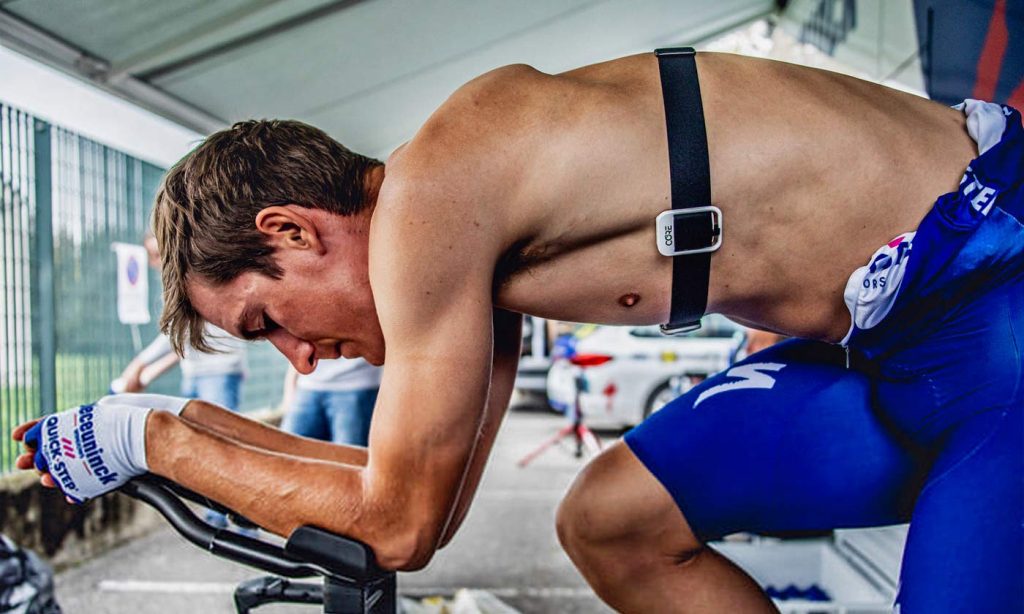Sports Science: Wearable Temperature Sensors

It’s 2024. Your phone just told you someone rang your doorbell and you weren’t there to hear it, you did 4000 steps today according to your smartwatch, and a wearable pinged saying you’re overheating. Wait, what!? Yes, some wearables now estimate your body temperature.
What exactly are wearables?
As a loose definition, wearables are devices that you wear that estimate or measure a value. They give you the value by literally just shrinking the technology or estimate the value based on other parameters.
We’ve previously written about heat and track cycling. If you follow tech closely enough, you’ll know that it’s possible for the average cyclist to purchase a wearable device that will estimate body temperature. One device that is heavily marketed to cyclist is the CORE sensor.
What is body temperature and why does it matter?
Humans operate within the narrow temperature range of ~36.5-37.5ºC. Our body controls our temperature with behaviours (putting on a sweater if you’re cold) or involuntary actions (sweating if you’re hot [1]. As we’ve previously mentioned, body temperature increases when we exercise. This is normal, but if we get too hot this can lead to illness or even death.
How do wearables estimate body temperature?
This depends on the device. According to their webpage, the CORE sensor measures the amount of heat leaving the skin in conjunction with heart rate to estimate temperature. Other wearables use an equation combined with heart rate and/or, skin temperature, skin heat flux, or accelerometry.
What are their advantages and limitations?
The major advantage is getting an estimate of your body temperature during exercise without invasive measures. The temperature of blood in the pulmonary artery is the best reflection of body temperature, but it’s invasive to measure [2]. There are also swallowable thermometer pills that exist, but they are one time use and pricey.
Like other wearables out there, there’s always a few flaws. Say you’re a fit person whose heart rate is low this would influence a body temperature based on heart rate for a given workload. If you’re a sprinter and you’re using caffeine your increased heart rate may overestimate your body temperature. Or imagine you’re really prepared for your 200 lap Madison, and you’ve drank an ice slushy before the race to lower your internal temperature a bit [3]. A sensor that uses skin temperature and heart rate would not pick that up.
Are they accurate?
Ultimately it depends on your application. At this point I would say they are good enough to observe trends and patterns. For clinical decisions or managing heat illness, wearables are not accurate enough yet [4]. Similarly for sports science and physiology research the accuracy needs to be improved. For sports science you’d want your sensor to differ <0.3ºC than the reference standard [5]. In one report the CORE sensor differed by more than 0.3ºC in about 50% of all the taken measurements [6].
Often wearables trade off convenience for accuracy. This is not bad or good. You just have to remember that the number you’re seeing is not the “gold standard”. At the end of the day, there’s a time and place for convenience and for accuracy.
Should cyclists use live estimated temperature data on the bike?
Right now I would not use estimated temperature data while riding for two reasons:
a) Studies show that the CORE sensor can underestimate high body temperature in males [6], and right now my own research (26 tests to date) shows that the CORE sensor overestimates body temperature in females. Other studies researching the CORE sensor in various scenarios agree that it still needs some work [3][7][8].
b) Body temperature increases when we exercise, this is normal. How much of an increase is too much varies from person to person and depends on their health, fitness, and acclimation status. Therefore, using a cutoff estimated temperature may not be functional. For example, a really interesting study showed that at the Doha UCI World Championships body temperatures of 41ºC were observed in some cyclists with no reported issues [9]. In a “normal” person however that could be grounds for heat stroke.
In my opinion I think that with continued improvements, the biggest future application for body temperature wearables in cycling will be for heat acclimation.
Take home message?
Technology moves fast, really fast. I recall saying in 2010 when power meters were coming out that I didn’t see a point in having one. I now own two and use them extensively in my training. Currently wearables that estimate body temperature are interesting tools but still have some development to do. Who knows where they’ll be in 5-10 years!?

Normand Richard
MSc, CSEP-CEP, ACSM-CET.
Richard Physiological Services
Physiologist & Occupational Fitness Consultant
PhD Candidate at Simon Fraser University
Normand has been involved in physiology for more than 10 years. He has research, clinical, occupational, and performance experience, and a professional consulting firm (richardphysiology.com). Outside of work he enjoys track racing for its community, simplicity, and challenge.
References
1. Périard JD, Eijsvogels TMH, Daanen HAM. Exercise under heat stress: thermoregulation, hydration, performance implications, and mitigation strategies. Physiological Reviews. 2021;101(4):1873–979.
2. Brengelmann G L. Dilemma of body temperature measurement. In: Shiraki K, Yousef M, editors. Man in stressful environments Thermal and work physiology. Spingfield Il: Charles C Thomas, 19875–22.;
3. Jolicoeur Desroches A, Naulleau C, Deshayes TA, Pancrate T, Goulet EDB. CORETM wearable sensor: Comparison against gastrointestinal temperature during cold water ingestion and a 5 km running time-trial. Journal of Thermal Biology. 2023 Jul;115:103622.
4. Hart D, Rischall M, Durgin K, Donoghue M, Pham T, Wyatt T, et al. Non-invasive zero-heat-flux technology compared with traditional core temperature measurements in the emergency department. The American Journal of Emergency Medicine. 2020 Nov;38(11):2383–6.
5. Ganio MS, Brown CM, Casa DJ, Becker SM, Yeargin SW, McDermott BP, et al. Validity and reliability of devices that assess body temperature during indoor exercise in the heat. Journal of Athletic Training. 2009;44(2):124–35.
6. Verdel N, Podlogar T, Ciuha U, Holmberg HC, Debevec T, Supej M. Reliability and validity of the core sensor to assess core body temperature during cycling exercise. Sensors. 2021 Sep 1;21(17).
7. Goods PSR, Maloney P, Miller J, Jennings D, Fahey-Gilmour J, Peeling P, et al. Concurrent validity of the CORE wearable sensor with BodyCap temperature pill to assess core body temperature during an elite women’s field hockey heat training camp. European Journal of Sport Science. 2023;(0):1–9.
8. Daanen HAM, Kohlen V, Teunissen LPJ. Heat flux systems for body core temperature assessment during exercise. Journal of Thermal Biology. 2023 Feb 1;112:103480.
9. Racinais S, Moussay S, Nichols D, Travers G, Belfekih T, Schumacher YO, et al. Core temperature up to 41.5oC during the UCI Road Cycling World Championships in the heat. British Journal of Sports Medicine. 2019 Apr 1;53(7):426–9.










